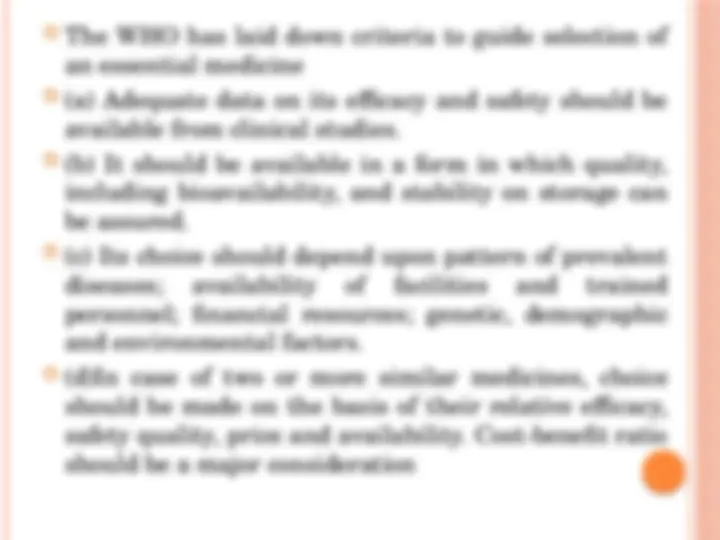











































Study with the several resources on Docsity

Earn points by helping other students or get them with a premium plan


Prepare for your exams
Study with the several resources on Docsity

Earn points to download
Earn points by helping other students or get them with a premium plan
Community
Ask the community for help and clear up your study doubts
Discover the best universities in your country according to Docsity users
Free resources
Download our free guides on studying techniques, anxiety management strategies, and thesis advice from Docsity tutors
An overview of pharmacy as the art and science of compounding and dispensing drugs, and introduces the field of pharmacology, which studies the science of drugs. various aspects of pharmacology, including the collection, identification, purification, synthesis, standardization, and quality control of medicinal substances. It also discusses the concepts of pharmacodynamics, pharmacokinetics, pharmacoepidemiology, pharmacoeconomics, pharmacotherapeutics, toxicology, and chemotherapy. the importance of pharmacology in healthcare and the various routes of drug administration.
Typology: Cheat Sheet
1 / 49

This page cannot be seen from the preview
Don't miss anything!










































Ms.Trambadiya Nehal V.
Rudolf Buchheim founded the first experimental
pharmacology laboratory in his own house in 1849 in
Germany.
Oswald schmiedberg, serturner, Magendie, John Abel,
Arthur Cushney, J. H. Burn and Gaddum made significant
contributions for the development of experimental
pharmacology during last one hundred years.
In India Sir Ram Nath Chopra made the beginning in
pharmacological research of traditional drugs.
The other outstanding pharmacologist who significantly
contributed to the growth of this discipline in India are R.
B. Arora, M.N. Ghosh, U. K. Sheth, P.C. Dandiya and K .P.
Bhargava.
Pharmacokinetics
What the body does
to the drug
Pharmacodynamics
This includes physiological and biochemical
effects of drugs and their mechanism of action
at organ system/subcellular/macromolecular
levels.
e.g.-Adrenaline
interaction with adrenoceptors
G-protein mediated stimulation of cell
membrane bound adenylyl cyclase
increased intracellular cyclic 3',5'AMP
cardiac stimulation, hepatic glycogenolysis and
hyperglycaemia, etc.
It is the scientific study of drugs in man.
It includes pharmacodynamic and
pharmacokinetic investigation in healthy
volunteers and in patients;
evaluation of efficacy and safety of drugs
comparative trials with other forms of
treatment
surveillance of patterns of drug use
adverse effects, etc.
The aim of clinical pharmacology is to
generate data for optimum use of drugs
and the practice of 'evidence based
This branch of health economics aims to quantify
in economic terms the cost and benefit of drugs
used therapeutically.
It arose from the concern of many governments
to provide for healthcare from tax revenues,
raising questions of what therapeutic procedures
represent the best value for money.
As with pharmacoepidemiology, regulatory
authorities are increasingly requiring economic
analysis, as well as evidence of individual benefit,
when making decisions on licensing.
It is the study of the genetic variations that cause
individual differences in drug response.
The underlying principle is that differences
between individuals in their response to
therapeutic drugs can be predicted from their
genetic make-up.
They mainly involve genetic polymorphism of drug-
metabolising enzymes or receptors
It is the study of poisonous effect of drugs and
other chemicals (household, environmental
pollutant, industrial, agricultural, homicidal)
with emphasis on detection, prevention and
treatment of poisonings.
It also includes the study of adverse effects
of drugs, since the same substance can be a
drug or a poison, depending on the dose.
It is the treatment of systemic
infection/malignancy with specific drugs that
have selective toxicity for the infecting
organism.
An official publication containing a list of
medicinal drugs with their effect and directions
for their use and published by the authority of
government or a medical or pharmaceutical
society.
as "those that satisfy the priority healthcare
needs of the population.
They are selected with due regard to public
health relevance, evidence on efficacy and
safety, and comparative cost effectiveness.
Essential medicines are intended to be
available within the context of functioning health
systems at all times and in adequate amounts,
in appropriate dosage forms, with assured
quality and adequate information, and at a price
the individual and the community can afford.
Any substance that can cause severe organ
damage or death if Ingested, breathed in, or
absorbed through the skin.
It refers to the requirement of higher dose of a drug
to produce a given response.
Loss of therapeutic efficacy (e.g. of salfonylureas
in type 2 diabetes), which is a form of tolerance, is
often called 'refractoriness‘.
Tolerance is a widely occurring adaptive biological
phenomenon. Drug tolerance maybe:
Rapid development of tolerance when doses of a
drug repeated in quick succession result in marked
reduction in response.
It is reversible in nature
This is usually seen with indirectly acting drugs, such
as; ephedrine, tyramine, nicotine.
These drugs act by releasing catecholamine in the
body, syntheses of which is unable to match the rate
of release stores get depleted.
Dependence
In medical terms, dependence specifically refers to a
physical condition in which the body has adapted to the
presence of a drug. If an individual with drug dependence
stops taking that drug suddenly, that person will
experience predictable and measurable symptoms, known
as a withdrawal syndrome.
Although dependence is often a part of addiction, non-
addictive drugs can also produce dependence in patients.
A prime example is prednisone, a synthetic form of the
steroid hormone cortisol that is used to treat asthma,
allergic reactions, Crohn’s disease, and many other
inflammatory conditions. Prednisone is not known to
produce addiction. However, if a patient has taken
prednisone for several weeks and then stops suddenly,
they are likely to suffer from withdrawal symptoms such
as fatigue, weakness, body aches, and joint pain